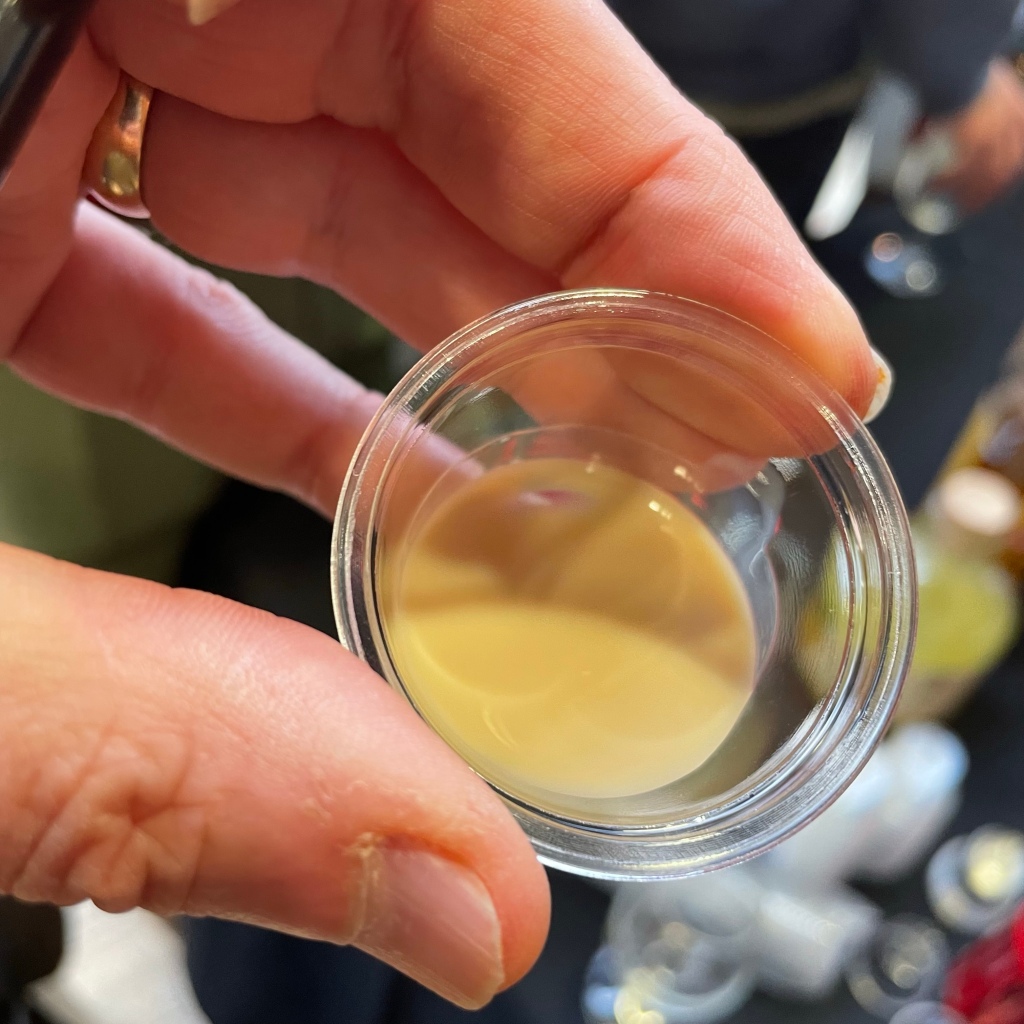Parts 1 and 2 of my selections from the Cork & Cask Winter Wine Fair contained wines from six small independent importers. Part 3 Shows some wines from Vine Trail, along with some delicious gems from Southern Spain poured on what I shall call the Cork & Cask table. Then we finish with some whisky and a rather nice liqueur from the Isle of Arran. That concludes this particular event. It should be said that everything on show, in all three parts, is stocked by Cork & Cask in their Edinburgh store (and available for UK delivery). That is an impressive, natural wine-focused, range.
It is pleasing to see that the natural wine offering in Edinburgh continues to grow, and that there is clearly a growing market for low intervention wines. My next port of call will be Spry Wines, where Modal Wines held their annual Scottish tasting for the trade a couple of days after the Cork & Cask Fair.
VINE TRAIL
Vine Trail has one of the most envied lists in the UK. Their focus is mostly France but with increasing diversity coming from Northern Spain and Sicily. They are especially strong (an understatement) in Grower Champagne, Burgundy, Alsace and Jura. To name a few of my all-time favourite producers which Vine Trail import, we have Champagne from Bérêche and Manu Lassaigne, from Alsace, Lissner and Tempé, and from Jura, Labet and Overnoy, to mention only two. That doesn’t even begin to scratch the surface.
Domaine Marc Tempé Riesling Amzelle 2019 (Alsace, France)
Marc and Anne-Marie Tempé farm eight hectares of vines at Zellenberg, all planted on a wide array of soils including limestone, clay, schist, various marls and sandstone. Established in 1993, by 1996 Marc had gone fully biodynamic (he was mentored by Léonard Humbrecht). Viticulture here is described as “fastidious” by his importer. Keys are very long lees ageing and minimal added sulphur (in the case of this cuvée, zero added SO2). These are terroir wines with concentration and ageability.
“Amzelle” Riesling has seen 24 months on lees in large foudres. It has a floral bouquet and is rounded and rich, with great depth of fruit. Pear flavours appear on the palate, with a spicy finish reminding me of both ginger and cinnamon. The alcohol is up at 14%, but it seems balanced. I think the 2018 strode in at 15% and I’m always criticised for being wary of such toppy Alsace wines as that, but I liked this one enough to recommend it highly. £35
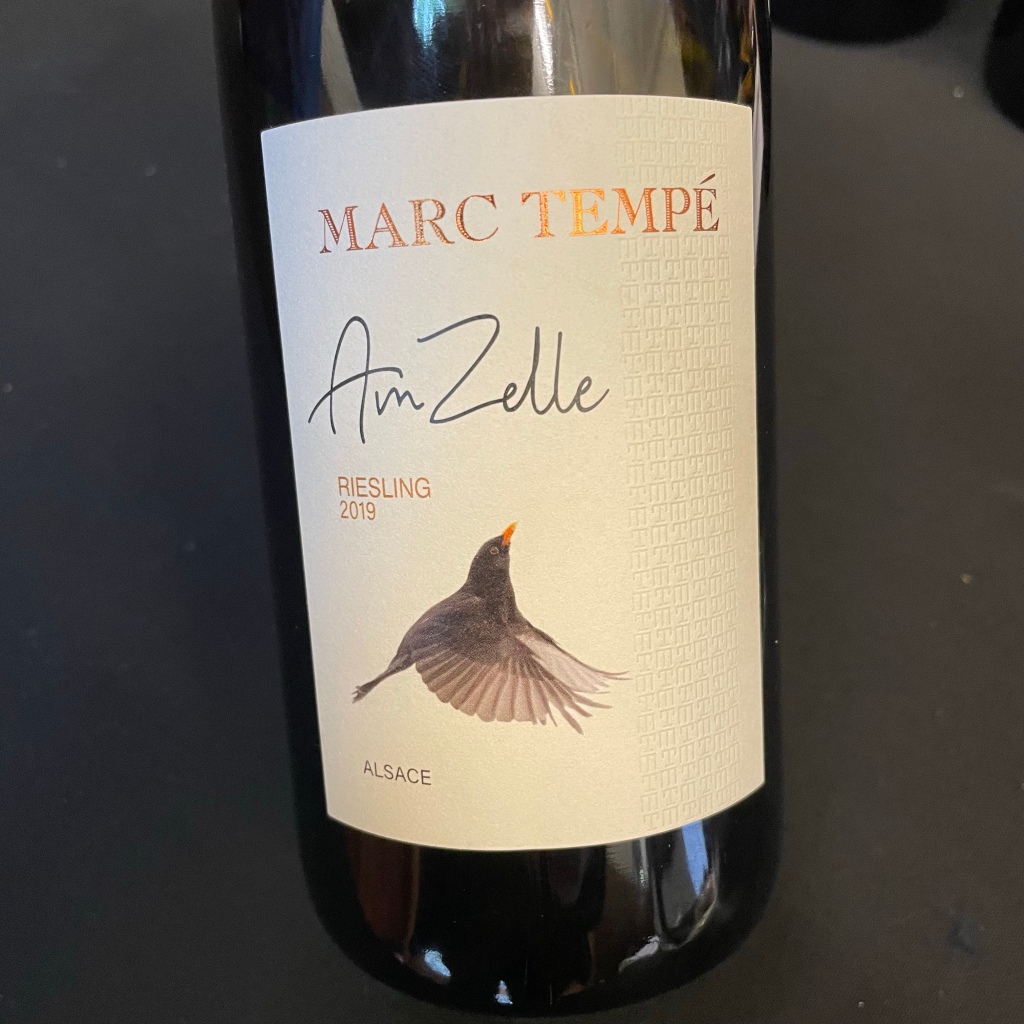
Domaine Bernard Gripa Saint-Joseph Blanc 2020 (Rhône, France)
One of the two most expensive wines I’ve written about from this tasting, but in my opinion worth seeking out. Fabrice Gripa (Bernard’s son) took over at this Mauves estate way back in 1997. He isn’t, of course, the most famous resident of the village, but he’s a star winemaker nevertheless. His reputation may rest with his St-Péray whites, but on this basis his St-Jo’ white is nearly as good.
Fabrice’s Saint-Josephs come off granite soils, whereas the St-Péray comes off loess, clay and limestone. The blend is currently 80% Marsanne with 20% Roussanne, from 30-year-old vines on slopes just to the north of Mauves. Aged in 800-litre demi-muids, of which approx. 10% are new, it is herbal and spicy with a hint of almond on the nose. Attractive now, it will certainly age, although drink one and you will find it hard to resist any other bottles you have…assuming you can afford £42, though I cannot fault the wine, nor the price. White Northern Rhône is altogether very much more impressive these days despite the fight to keep alcohol levels down below 15%.

Veronica Ortega Bierzo “Quite” 2020 (Bierzo, Spain)
I went to Bierzo once you know! It was 1988, the wines were then called “El Bierzo”, and we had to stump up for the Parador as there weren’t many tourists, bar those who passed through Villafranca del Bierzo on the Pilgrim Route to Santiago. Veronica is to the east of Villafranca, near Ponferrada (which we visited briefly) at Valtuille de Abajo, where she has around 6ha planted.
The list of famous wine estates where Veronica has worked is impressive but way too long to list (from Burn Cottage to DRC but that’s not even getting started), but this native of Cadiz (her dad was a bullfighter, apparently) chose the province of Léon to make her own wine. I met Veronica a few years ago in London and tasted her range. Massively impressed, I bought a number of her wines from Vine Trail and from Littlewine when they had an online shop. I went directly to Cork & Cask’s shop after the event, and this was one of the wines I bought.
Quite is 100% Mencia from organic parcels around Valtuille. The soils are iron-rich clay and sand. Winemaking is fairly straightforward, a 15-day cuvaison, then a nine-month spell ageing in a mix of second and third use oak, and amphora. It’s a fruity wine, dark fruits sitting on a deep mulberry bed. It’s also savoury and grippy, but will drink nicely now or keep a year or two. Mine won’t last too long. £24
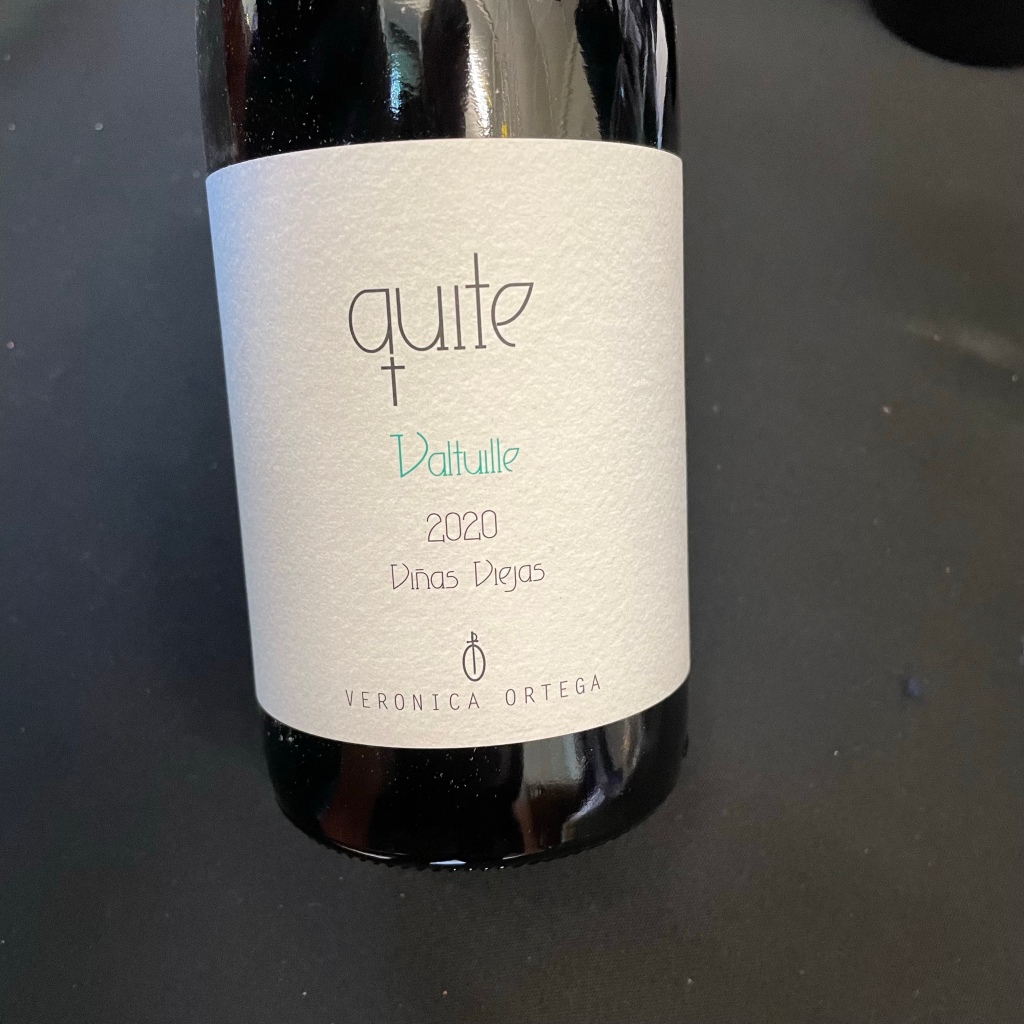
Cédric Perraud Etna Rosso Goccia 2021 (Sicily, Italy)
I had a phase drinking a lot of Etna wines some years ago, but the best of them just became too expensive, and if truth be known, less good value compared to other regions. The winemakers became stars and prices shot up.
Cédric Perraud, who comes originally from Nantes, on the Loire, began working some old vineyards on Etna in 2014, on the northern and eastern side of the mountain. His own winery began production in just 2017. The grapes for this cuvée come from old bush vines around Randazzo, where Cédric lives.
Goccia Rosso is mostly comprised of the great grape of Etna, Nerello Mascalese, with a little Carricante and Minella. Fermentation lasts just ten days, but on skins, before resting in stainless steel until the following May, to give what is a fresh and fruit-driven wine despite a reasonable 13% abv. It has that brittle spine surrounded by fruit that you expect from the cooler parts of Etna, with a touch of mountain viticulture about it, with vines right up at between 600 and 850 masl. You can almost smell the wood smoke. Yet there is also body here, and some tannin, in what is a natural wine, although a little SO2 is added at bottling. £32
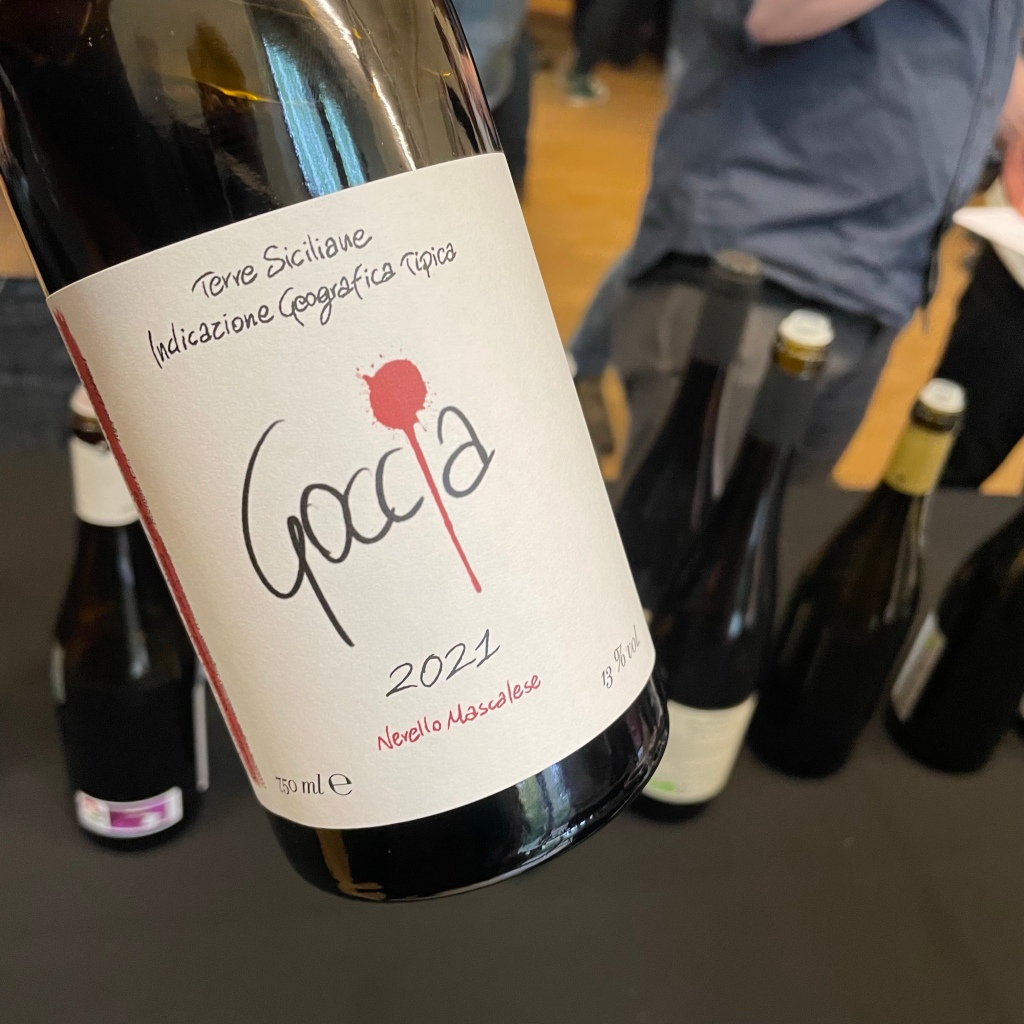
CORK & CASK TABLE
The shop’s own team were pouring a selection of wines on a couple of tables where their importers were in most cases unable to attend. On one of those tables I was particularly interested to try some rather unusual wines from Bodega Vinificante Mahara (Cadiz) which add another new dimension to the wines of wider Jerez. Then, staying with Jerez, I must mention the wines of Diatomists. These are fine Sherries without the price tag of some, which I devoted a whole article to last year (if interested you can search for it, article published 01/12/2022).
Bodegas Vinificante Mahara: Amorro Pet Nat, Blanco and Tinto (Jerez Region, Spain)
Mahara means “crazy”, and the crazy bodega, run by the “crazy brothers”, is situated in the town of San Fernando, with around 5ha of vineyards at Chiclana, Sanlúcar and Jerez, mostly on the white albariza soils.
The Pet Nat is made from Sanlúcar Palomino, which I would imagine will make a lot of readers perk up and take notice. About 9,000 bottles were made and they used the classic ancestral method, but with an unusually long time on lees: four years! It’s a natural wine with just a tiny amount of sulphur added at bottling. Very different, very cool, very nice and well worth grabbing to try if you are anything like me (a sucker for the unusual stuff). £24
Amorro Blanco is a white Vino de Mesa made from Palomino grown, I think, at Chiclana. It has a shorter ageing on lees and it is relatively simple, in essence a salty Atlantic-influenced white wine with all the character that entails. Good, but for me not quite as out there as the Petnat and the red below. But nicely priced at £22, the cheapest of the three.
Amorro Tinto This is a red wine made from Tintilla di Rota, a variety mostly used elsewhere to make simple sweet wines, here fermented dry and aged in fibreglass tanks. The fruit source is the fine albariza soils of Jerez’s Pago Balbaina. This table wine really does have a hint of the ocean about it. A five-day whole bunch fermentation creates a fruity wine, but one with a salty twang on its savoury finish. It is unusual for a Southern Spanish red, not that you see many reds from Jerez, tasting lighter than its 13.5% abv suggests. £23
Three wines here which stand out as unusual and super-interesting, but exceedingly drinkable, are all well-priced, and as in 2022 with Diatomists, Southern Spain has thrown up more little gems.

Diatomists (Jerez, Spain)
As I mentioned above, you can read about the Diatomists project in an article I wrote last year, published on 1 December. In that article I tasted their Manzanilla, Amontillado, Oloroso, Medium Sherry and PX. This time out there were just three on show, the dry Manzanilla, the dry and nutty Amontillado and the super-sweet Pedro Ximénez, possibly my favourites in the range, at least at last year’s tasting.
Manzanilla is from the lower part of the famous Pago Miraflores Baja. The solera is 30 years old, comprised of 500-litre chestnut casks. The wine is dry yet a tiny bit richer and less acidic than many Manzas. Very good, £15 for a half bottle (I do note that these have all gone up in the intervening year but let’s face it, others are to blame rather than the producer or retailer).
Amontillado from a solera that has been going a hundred years, although this wine is only around twelve years old. It is once more unusually fruity for a dry Amontillado, although it has that nuts and salt thing going on that cries out for some fine Brindisa Marcona salted almonds and Perello queen olives. Enough to make the Amontillado-haters change their mind. £20/half bottle.
Pedro Ximenez (PX) is a style very few wine lovers I know drink often, but perhaps Christmas will be the exception. Last year our Christmas Pudding wine, then going well with the leftovers, nuts and nibbles in the evening, was a Vin Santo. Have you seen the price of good Vin Santo now! This PX comes from Montilla Morilles and like most good PX, it has a powerful bouquet. What struck me last year was that this PX actually has some acidity. Okay, it’s really sweet, but it isn’t as overwhelmingly cloying as most. I just wish it wasn’t £20/half, but Isole e Olena Vin Santo is £60/half so I should shut up and stop complaining.
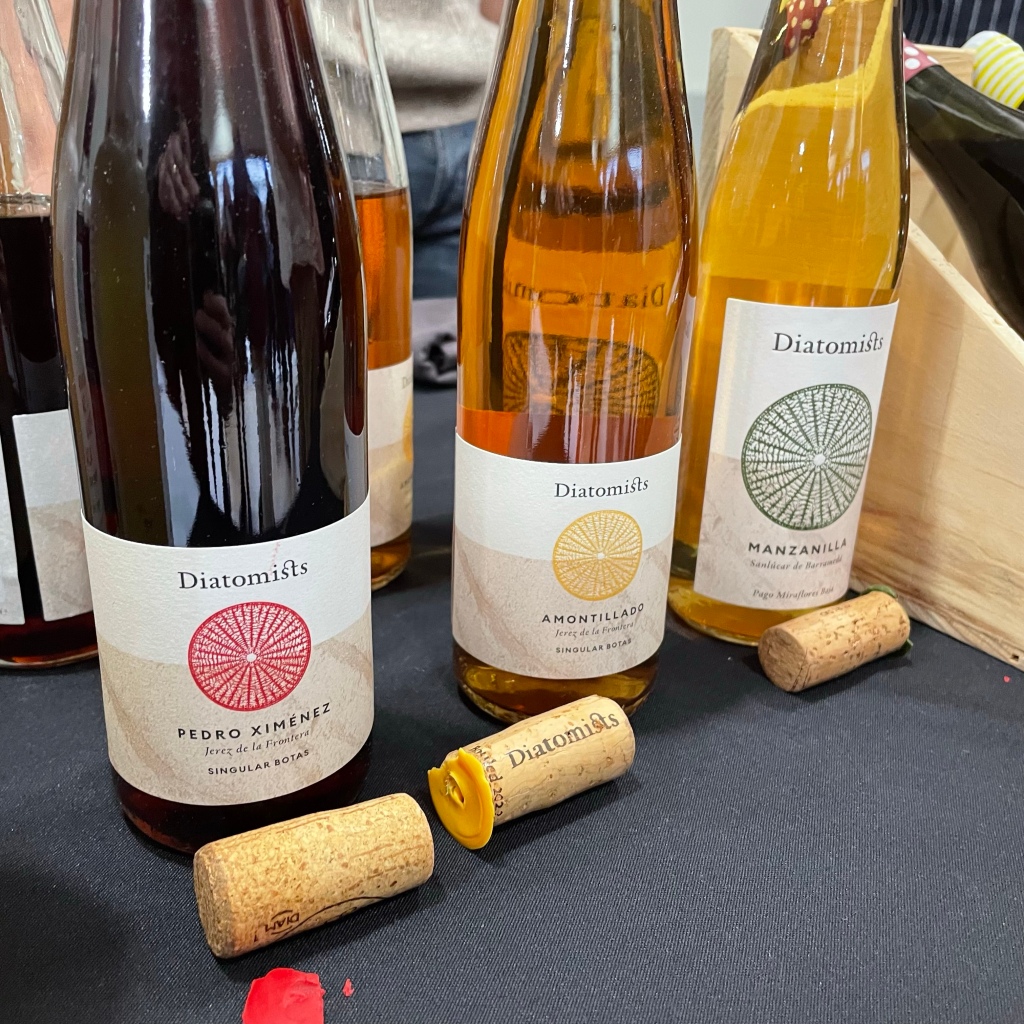
ISLE OF ARRAN DISTILLERIES
Arran is the southernmost of the larger isles off Scotland’s West Coast, although the Kintyre Peninsula and Campbeltown stretch further south, and it is also the largest island in the Firth of Clyde. Its proximity to, and accessibility from, Glasgow makes it a major tourist destination today, although before Arran’s own version of the “clearances” it was a remote island of subsistence agriculture. One is always sceptical of legends of illicit distilling but it seems in Arran’s case these were true and the “Water of Arran” was apparently revered throughout Scotland in the 18th and early 19th centuries.
Arran did have a licensed distillery during the first half of the nineteenth century but it closed in 1837. The new Arran Distillery opened only twenty-odd years ago, on the north coast at Lochranza. More recently, a new distillery under the same management was opened near the site of that 19th century operation, on the south coast at Lagg. In keeping with the island’s tourist potential, a much-awarded visitor centre welcomes those who wish to connect with this island’s whisky heritage. Close to 100,000 folks a year do.
As a rough rule of thumb, the Arran Distillery at Lochranza makes unpeated malts, said to be in the Speyside style, whilst Lagg is making a peated malt more in keeping with the island style of Islay. There has been a revamp of the packaging in recent years and the Arran single malts are very well presented. The Arran releases are of particular interest to wine lovers because they draw on some adventurous cask finishes.
First, look out for my favourite previous release. It’s an Amarone cask finish. Red wine casks are less common and I’ve never come across an Amarone cask before. It has a nice red label in the new Arran bottle and livery, and the cask influence can clearly be identified. I’d say you get cherry and chocolate on the nose and the palate has a very wine-like “red fruits” element. This release may be hard to find but it is still available and usually retails at around £54.
First up at the tasting was the Sauternes cask finish, which is one of my favourites currently on my whisky shelf. Again, although an amateur like me might not identify the cask blind, if you know what it is then there’s a real moment of recognition. For instance, you certainly get the sweeter notes of the whisky enhanced. The nose shows citrus and honey, and the palate has some vanilla. There’s a touch of apricot on the finish. Also, circa £54. These special cask finishes are released at a slightly higher abv, around 50%.
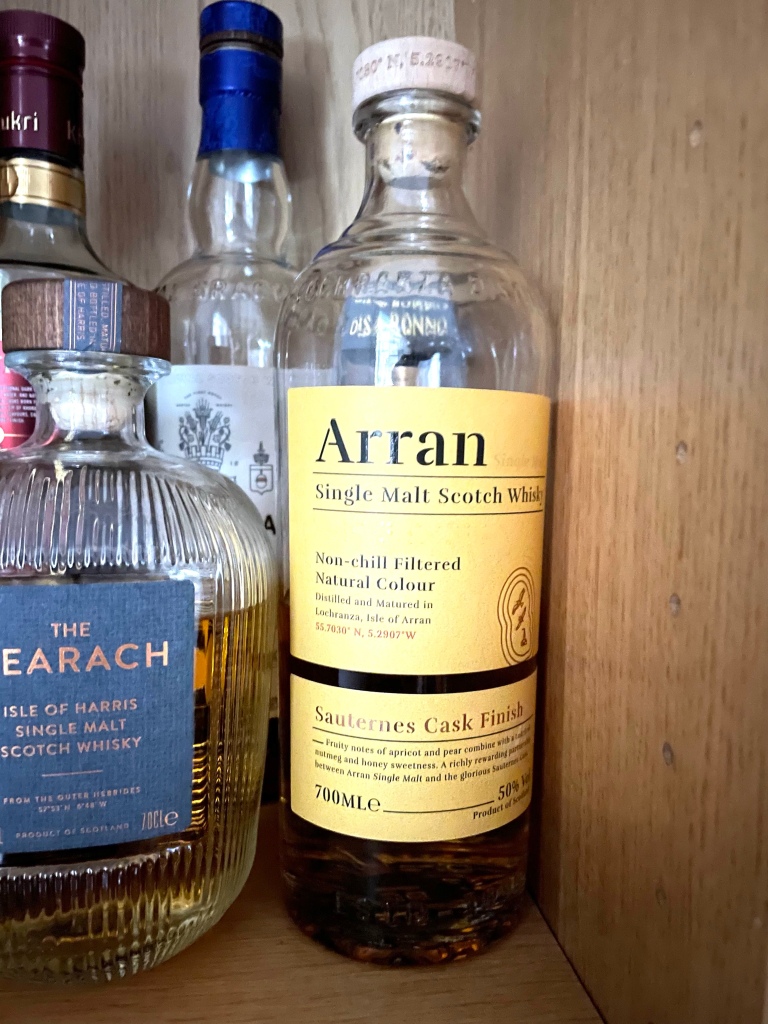
Arran lacked a fine reputation when it opened its doors, but I think these special finishes are lovely bottles. I’ve been hit hard on the Sauternes finish, being unable to steer guests away to other bottles, so I may need to buy another.
I also tasted the Sherry cask finish, called “The Bodega”, the latest release. It’s an 8-9-year-old whisky, and described as a return to the style of some of Arran’s earlier releases. Expect a slightly spicier whisky, but one which still has a nice aromatic sweetness and a little smoke. This cask finish fetish is a dangerous habit to develop. 55% alcohol (cask strength), c £60.
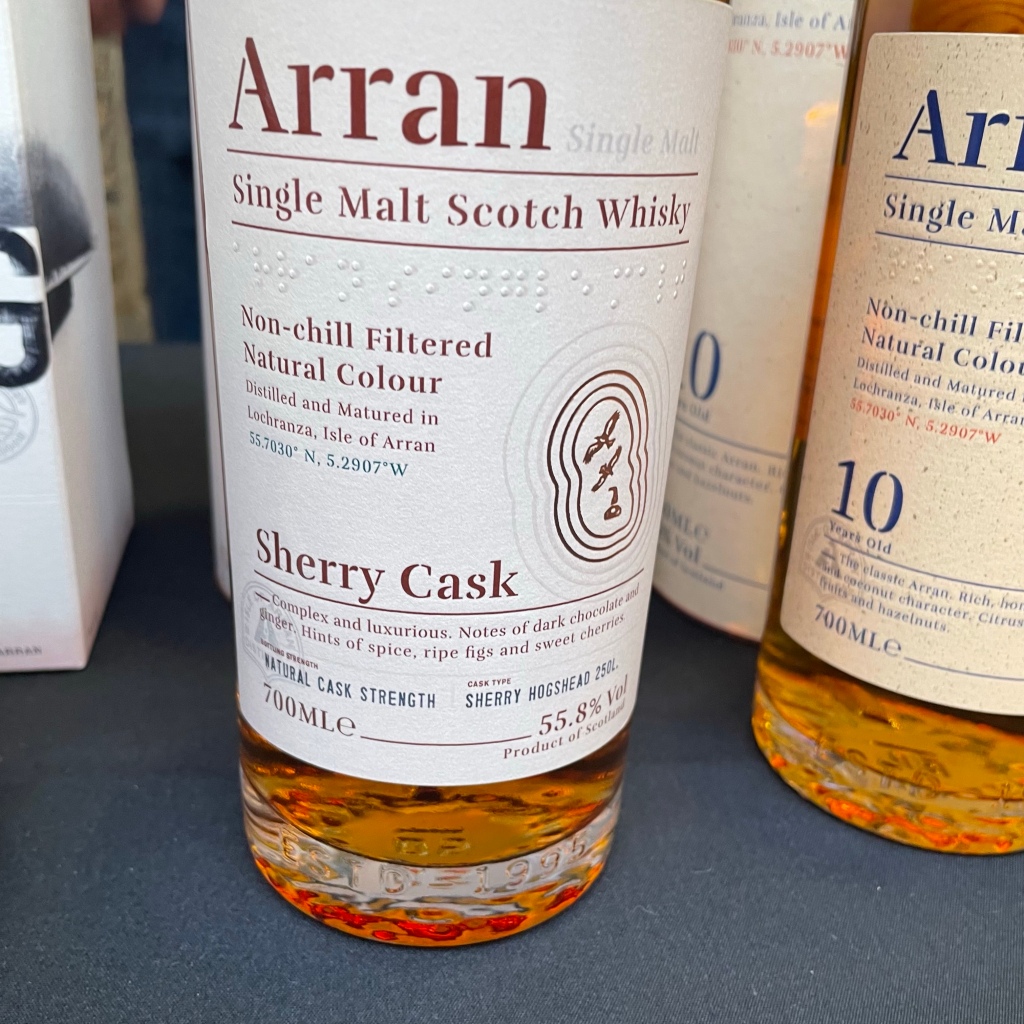
I mentioned the new distillery at Lagg. Here I tasted the Lagg “Corriecravie”. Just 300 cases were released. For this they use Concerto malted barley, and water from Lagg distilleries own borehole. It has been finished in Oloroso cask and was bottled at 55.8% abv. This bottling is more peaty, and more smoky, than the Arran releases, and at just four years old it does have a fiery side (it does taste like a young malt). However, given its age, it is surprisingly smooth as well, and certainly shows some complexity (and meatiness). Oak, smoke, nutty and chocolaty. It comes in at £68. For me, I prefer the Arran releases (and I’d like to try the Port cask finish some time), but I know others prefer the peaty style.

Before I leave Cork & Cask, I have to mention the Arran Gold Cream Liqueur. If, like me, you are partial to that other famous cream liqueur, if the occasion is right, of course, then you really should try this. It’s so many steps up it’s a whole damn staircase better…in my humble but sober opinion. It has enough whisky to bring it up to 17% abv, like its commercial rival, but I’d warrant that probably doesn’t have spirit of the same quality. The Arran is also smooth and creamy, with vanilla fudge on the nose. It actually has complexity, of sorts. I found this exceptional. I should emphasise, in case you are worried about my judgement, that despite all those wines I’d tasted, I was spitting.

